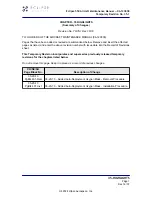
CESSNA
MODEL 172N
SECTION 3
EMERGENCY PROCEDVRES
INTRODUCTION
Section
3
provides checklist and amplified procedures for coping with
emergencies that may occur. Emergencies caused by airplane or engine
malfunctions are extremely rare if proper preflight inspections and
maintenance are practiced. Enroute weather emergencies can be minim
ized or eliminated by careful flight planning and good judgment when
unexpected weather is encountered. However, should an emergency arise,
the basic guidelines described in this section should be considered and
applied as necessary to correct the problem. Emergency procedures
associated with ELT and other optional systems can be found in Section 9.
AIRSPEEDS FOR EMERGENCY OPERATION
Engine Failure After Takeoff:
Wing Flaps Up . .
Wing Flaps Down
Maneuvering Speed:
2300
Lbs
1950 Lbs . . . .
1600 Lbs . . . .
Maximum Glide . .
Precautionary Landing With Engine Power
Landing Without Engine Power:
Wing Flaps Up . .
Wing Flaps Down
. . . .
OPERATIONAL CHECKLISTS
ENGINE FAILURES
ENGINE FAILURE DURING TAKEOFF RUN
1.
Throttle -- IDLE.
2.
Brakes -- APPLY.
3.
Wing Flaps -- RETRACT.
4.
Mixture -- IDLE CUT-OFF.
5.
Ignition Switch -- OFF.
6.
Master Switch -- OFF.
1 July 1979
65 KIAS
60
KIAS
97 KIAS
89 KIAS
80 KIAS
65 KIAS
60 KIAS
65 KIAS
60 KIAS
3-3
Содержание 17273274
Страница 8: ......
Страница 18: ......
Страница 38: ......
Страница 72: ......
Страница 92: ......
Страница 94: ......
Страница 116: ......
Страница 118: ......
Страница 123: ...SECTION 7 AIRPLANE SYSTEMS DESCRIPTIONS 7 6 Figure 7 2 Instrument Panel Sheet 1 of 2 CESSNA MODEL 172N 1 July 1979 ...
Страница 158: ......
Страница 160: ......
Страница 176: ......
Страница 178: ......












































